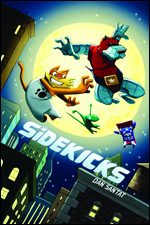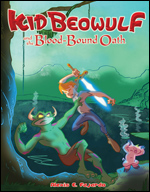Katie’s Korner: Graphic Novel Reviews for Schools and Libraries
 Sidekicks, by Dan Santat
Sidekicks, by Dan Santat
Published by Scholastic
ISBN: 9780-4-3929-819-3
Ashamed as I am to admit this, I must say that the word "sidekick" alone has always made me think very narrowly, only of Batman's Robin. In my mind, Robin is the best sidekick of comic book lore. Loyal, trustworthy, an apprentice in training - or a student determined to master his trade - Robin has always been driven by respect and passion, two ingredients that make for the perfect student-teacher relationship.
Today, however, Batman's Robin has some serious competition, and I am both surprised and horrified at myself for not thinking about the character of a "sidekick" any differently until now. Being a pet lover who treats my dogs like children, I myself have two sidekicks, which Webster's Dictionary refers to as "assistants" or "helpers." The most respectful (if you don't count the tendency to bark too much) and passionate sidekicks on the planet, both of my dogs are destined to become superheroes. Making a sad day happy, a discouraging day promising, or a frustrating day exhilarating, both dogs intuitively come to the rescue.
With a humble bow and a "thank you" to Dan Santat's Sidekicks teachers, librarians, and students can also broaden their understanding, familiarity, and schema about "sidekicks." Focused on a story within a story, Santat's Sidekicks moves readers away from a traditional focus on a superhero who alone saves the day. "Let's face it," Captain Amazing's character seems to tell himself, "I am getting older and need a sidekick. In fact, I think I should hold some auditions."
When they overhear news of Captain Amazing's sidekick auditions his pet dog, hamster, and chameleon each decide that they are the loyal and courageous pet-sidekick for the job. But there's a problem. A superhero's work is never done and Captain Amazing has been too busy saving the world each and every day. As a result, he hasn't been able to pay too much attention to his pets; he's been busy saving the world.
With each pet determined to prove that his or her superhero sidekick powers are just what Captain Amazing is looking for, some household, family drama ensues. But battling each other is not what the Captain needs, for Dr. Havoc has returned to town, and Captain Amazing needs the help of each of his sidekick companions. Can they team up? Will Captain Amazing realize just how valuable they are as a superhero team? Or should he just hang up the cape?
Sidekicks puts an entirely new spin on not only what makes a superhero, but also what makes a superhero team.
English Language Arts Elements of Story
Plot: Captain Amazing needs a sidekick, and, unbeknown to him, his very best friends - his pets - have developed superhero powers
Setting: Captain Amazing's home, Metro City
Major Characters: Captain Amazing (aka, Harrison "Harry" Blake), Dr. Havoc, Roscoe ("Metal Mutt"), Shifty ("The Chameleon"), Fluffy, The Claw ("Manny" or "Static Cat"), Wonder Man, Nummers
Themes: Family, Friendship, Loyalty, Trust, Good and Evil
Traditional and Contemporary Literary Pairing Suggestions: Animal Farm by George Orwell, The Little Mermaid by Hans Christian Andersen, Black Beauty by Anna Sewell, The Outsiders by S.E. Hinton, The Jungle Book by Rudyard Kipling, Peter Pan by J.M. Barrie, The Wizard of Oz by L. Frank Baum, Garfield by Jim Davis, Calvin and Hobbes by Bill Watterson, Peanuts by Charles M. Schulz, The League of Extraordinary Gentlemen by Alan Moore, Fantastic Four by Stan Lee
Teaching Recommendations For Middle School Readers
Suggested Alignment to the IRA /NCTE Standard(s):*
- standard #s correspond to the numbers used by IRA/NCTE
1. Students read a wide range of print and nonprint texts to build an understanding of texts, of themselves, and of the cultures of the United States and the world; to acquire new information; to respond to the needs and demands of society and the workplace; and for personal fulfillment. Among these texts are fiction and nonfiction, classic and contemporary works.
2. Students read a wide range of literature from many periods in many genres to build an understanding of the many dimensions (e.g., philosophical, ethical, aesthetic) of human experience.
3. Students apply a wide range of strategies to comprehend, interpret, evaluate and appreciate texts.
Suggested Reading Lesson Plan
Santat's Sidekicks easily lends itself to a reading comprehension lesson plan focused on characterization. Structured as a stations activity, teachers and librarians can post character stations around the room; using large poster board or paper each station should have one of the character's names on it. Each station should also provide students with various writing utensils.
Following up on each night's reading assignment, students should be asked to visit each station and spend from 5 - 10 minutes recording what they know about that character, at that point in the story. Over several class periods, students will have created a running log of each character's traits.
For assessment, teachers and librarians can ask students to discuss and explain what they wrote about each character and why.
The following list outlines the main characters students should be asked to think about from station to station: Captain Amazing (aka, Harrison "Harry" Blake), Dr. Havoc, Roscoe ("Metal Mutt"), Shifty ("The Chameleon"), Fluffy, The Claw ("Manny" or "Static Cat"), Wonder Man, Nummers.
 Kid Beowulf and the Blood-Bound Oath, by Alexis E. Fajardo
Kid Beowulf and the Blood-Bound Oath, by Alexis E. Fajardo
Published by Bowler Hat Comics
ISBN: 978-0-98014-191-7
Just the other day a group of pre-service teachers asked me if I knew any "good adaptations or spin-offs" of traditional literature. As if to sprinkle the question with extra difficulty one student added "most middle level students really like series books. Any of those?"
"Yes!" I responded.
Alexis Farjado's Kid Beowulf series is an excellent reimagination of the traditional Beowulf tale. Familiar to generation-upon-generation of student readers, Beowulf has typically found its way onto almost every canonical list of "must reads." Today, however, teachers have the opportunity to teach Beowulf to an entirely new generation of readers, readers whose daily lives are spent reading both print-text literacies and image literacies. With Beowulf's legacy in mind, and Fajardo's graphic novel reimagination of a modern-kid-friendly version of the tale freshly checked off my reading list, I immediately ran back to my office to grab Farjado's version and bring it back to my teachers.
An engaging, action-packed, and modern adventure that smoothly introduces middle level and high school level students to the traditional Beowulf storyline, Farjado has hit a contemporary, literary home-run. While Farjado's Kid Beowulf is historically thoughtful and well-researched, it is also creative and freshly exciting, for it creates new room and space for Beowulf to recreate itself for generations to come.
English Language Arts Elements of Story
Plot: The first book in the Kid Beowulf series, Kid Beowulf and the Blood-Bound Oath takes a look back in time at the disturbing and yet intriguing origins of two familiar twin brothers, Beowulf and Grendel
Setting: Geatland, Germania, Brittania, Francia, Hispania, Italia, Lydia, Kieven Rus
Major Characters
• The Danes, from Daneland: King Shild, his sons Hrothgar and Orgier, and their Great Dane Wulf
• The Heathobards, from Germainia: led by Dagref, Dagref's daughter Froda, Yrs and her father Ingeld are the newest additions to Daneland
• The Geats: longtime allies of the Danes, Hrethel is their leader, Heglic his son, and Edgetho a loyal and adopted son to this family
• The Dragon: oldest living creature in the story, lives deep below the water in the meer (or a cave), was present during Gertude's birth, and also present at the birth of the twin brothers, Grendel and Beowulf
• Welthow: Hrothgar's fururisic bride, and ultimately Queen of Daneland
Themes: Legend, Fantasy, Family Loyalty, Mysticism, War and Strife, Consequences, Vengeance, Wisdom, Man and Nature, Man and the Supernatural
Traditional and Contemporary Literary Pairing Suggestions: J.R.R. Tolkien's The Hobbit and Lord of the Rings Trilogy, Homer's The Odyssey, any Star Wars text, movie or graphic novel, Chaucer's The Canterbury Tales, Little Women by Louisa May Alcott, The Christmas Carol by Charles Dickens, The Odyssey by Gareth Hinds (graphic novel version), Kevin Crossely-Holland's Arthur Trilogy, Belle Yang's Forget Sorrow
Teaching Recommendations For Advanced Middle School Readers and High School Readers
Suggested Alignment to the IRA /NCTE Standard(s):*
- standard #s correspond to the numbers used by IRA/NCTE
7. Students conduct research on issues and interests by generating ideas and questions, and by posing problems. They gather, evaluate, and synthesize data from a variety of sources (e.g., print and nonprint texts, artifacts, people) to communicate their discoveries in ways that suit their purpose and audience.
9. Students participate as knowledgeable, reflective, creative, and critical members of a variety of literacy communities.
10. Students use spoken, written, and visual language to accomplish their own purposes (e.g., for learning, enjoyment, persuasion, and the exchange of information).
Suggested Creative Writing Lesson Plan
To begin, teachers and librarians should prepare and introduce the historical fact that Beowulf has stood the test of literary time and fame. Perhaps on a timeline with a few sample reading selections, this background will provide a sense of depth for middle and high school level readers.
Following on the heels of this historical platform, teachers can then present students with Farjado's new, reimagined version of the story. With one or more of Farjado's Kid Beowulf texts read and discussed, teachers can then really focus on how Farjado rewrote and reimagined a traditional story for modern readers. For instance, they can ask their students to do the same thing with the following writing prompt: "After learning about Beowulf's history and Farjado's reimagining of the story, what storyline seeds would you like to pull out, reimagine, and build upon in your own rewriting of this traditional text?"
A creative writing lesson with an infinite amount of possibility, teachers and students alike are sure to enjoy not only rewriting their own versions, but also explaining why the rewrote their version in their own, unique way.
Note: Students should be encouraged to reimagine the story in either print-text format or graphic novel format.
Katie Monnin, PhD, is an assistant professor of literacy at the University of North Florida and author of Teaching Graphic Novels: Practical Strategies for the Secondary ELA Classroom (2010) from Maupin House. To learn more about Teaching Graphic Novels or Katie Monnin, please go to this link: http://www.maupinhouse.com/monnin.php.


